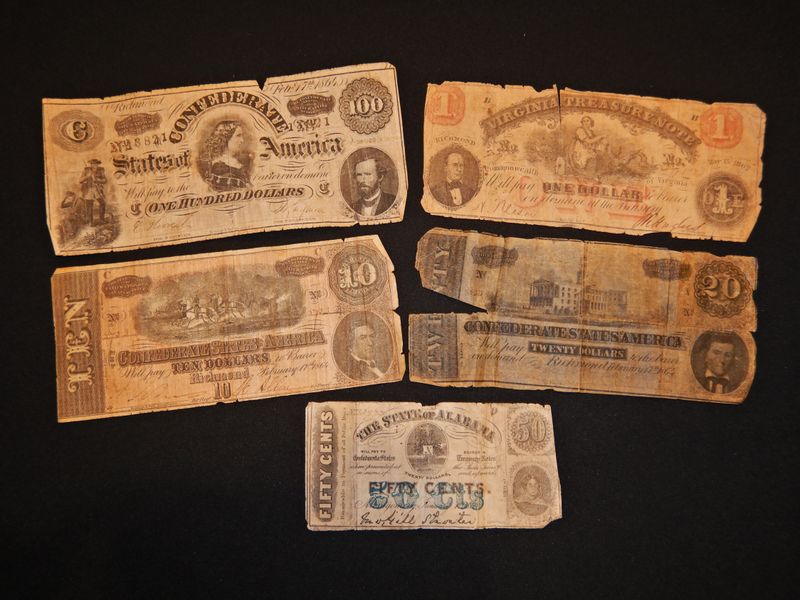The Rise & Fall of the Confederate Dollar
Last Updated 4/20/2024
By Jubilee P. Reid

War is expensive. With the outbreak of the American Civil War in the spring of 1861, the 11 states forming the newly created Confederate States of America (CSA), needed to produce their own currency. However, a problem arose because there were few if any skilled engravers or printers in the seceded states as the printing business was a Northern industry. On March 9, 1861, the Confederate government approved the printing of one million dollars of paper currency. Ironically, this first batch of Confederate banknotes was printed in New York City by the National Bank Note Company and was smuggled back into the South. Having their money printed in enemy territory was unsustainable so the Confederate government resorted to employing multiple private print companies throughout Louisiana, South Carolina, and Virginia to produce currency.
Though individual banks were permitted to produce paper bank notes, the United States government did not officially began printing and circulating paper money until the Civil War had begun. Minted coins were the standard currency. Paper currency production was begun mainly to finance the war and continued successfully. All U.S. bills printed since the Civil War are valid tender today.
Believing that a Southern victory was eminent, Confederate banknotes (or “graybacks” as they were called due to the color of CSA uniforms) were not backed by silver or gold, as the Union’s currency was. Instead, these promissory notes had dates for fulfillment such as “six months after the ratification of a treaty of peace between the Confederate States and the United States of America.” As the South lost confidence in a Confederate victory, the dates stretched from six to twelve months to two years. A limited supply of precious metals meant that coin minting was not sustainable for the Confederacy. Expecting to quickly win the war, they minted very few coins, deciding that producing paper currency with future backing from physical treasury resources after victory was a better plan. Also, the few Confederate mints were captured by Union forces early in the war; printing equipment was easier to relocate as battle lines moved.
Due to the shortage of skilled engravers in the southern states, and the variety of printing companies contracted, the Confederacy produced a conglomeration of banknotes with diverse designs and varied quality. Between 1861 and 1864 the Confederates produced 72 patterns of currency. They used many common designs for their banknotes including Founding Fathers who came from the South, and mythological Greek gods. They also used ships, trains, and various Southern politicians. Five patterns depicted enslaved people working in cotton fields, glorifying the Confederacy’s cotton industry. Some of the notes had designs printed on both sides while others were single sided. Individual Southern states such as Virginia and Alabama printed their own state money during the war, adding to the Confederacy’s financial chaos.
This inconsistency created an ideal situation for forgers. Large amounts of counterfeit banknotes were produced, a practice which the Union participated in. Counterfeit currency was distributed throughout the Southern states by the Union. As the war dragged on, the Confederates continued printing currency to fund the war effort. This overprinting combined with the rising prices of goods, caused extreme inflation. A few months before the end of the Civil War, one Confederate dollar was equal to three cents in U.S. currency. With the Confederate surrender at Appomattox in April 1865 and the disbanding of the Confederacy, these banknotes lost all monetary value.
Displayed in the Civil War Exhibit of the McMinn County Living Heritage Museum is a collection of Confederate banknotes including 1-, 10-, 20-, and 100-dollar bills and a 50-cent bill. The one-dollar note was printed by the Treasury of Virginia while the 50-cent note was printed by Alabama. The 10-, 20-, and 100-dollar bills were part of the Confederacy’s seventh series of printing, all stamped with the date February 17, 1864. The seventh series included the printing of approximately 470 million dollars’ worth of double-sided currency and was the final series printed by the Confederacy. It was labeled to be fulfilled by the CSA Treasury two years after a Confederate victory. The museum’s banknotes were printed by Keatinge & Ball of Columbia, South Carolina.
Keatinge & Ball began in 1861 when English engraver Edward Keatinge (1823 – 1894) left the National Bank Note Company in New York, at the request of the Confederate Treasury Secretary Christopher Memminger. He joined lawyer Thomas Ball to form the corporation in Richmond, Virginia. Keatinge & Ball became the primary supplier of Confederate banknotes due to the expertise of their engravers. Later in the war, the company moved to Columbia, South Carolina to avoid the constant threat of attack in Richmond. William Leggett joined Keatinge & Ball in September of 1861 as an expert at lettering and for a while the corporation included his name in their title. Only seven months later, he was forced to resign after Secretary Memminger accused him of being a Union spy. In February of 1865, just before the end of the war, Keatinge & Ball was dissolved after unresolved disputes with the Confederate government. This was ideal timing to disband as Sherman’s troops entered Columbia on February 17, 1865 on their “March to the Sea” leaving a trail of mass destruction in their wake. The Keatinge & Ball building and equipment was destroyed in the following riots.
The museum’s 100-dollar note features Confederate General George Wythe Randolph (1818 – 1867) and First Lady of South Carolina, Lucy Holcombe Pickens (1832 – 1899), the only woman to be depicted on Confederate currency. The 20-dollar note depicts the Tennessee State Capitol and the 10-dollar note features horses pulling a cannon.
Although Confederate banknotes are not legal currency, they are now worth much more than they were during the Civil War as antique collector’s items and a considerable number of these banknotes still exist among museums and collectors.

